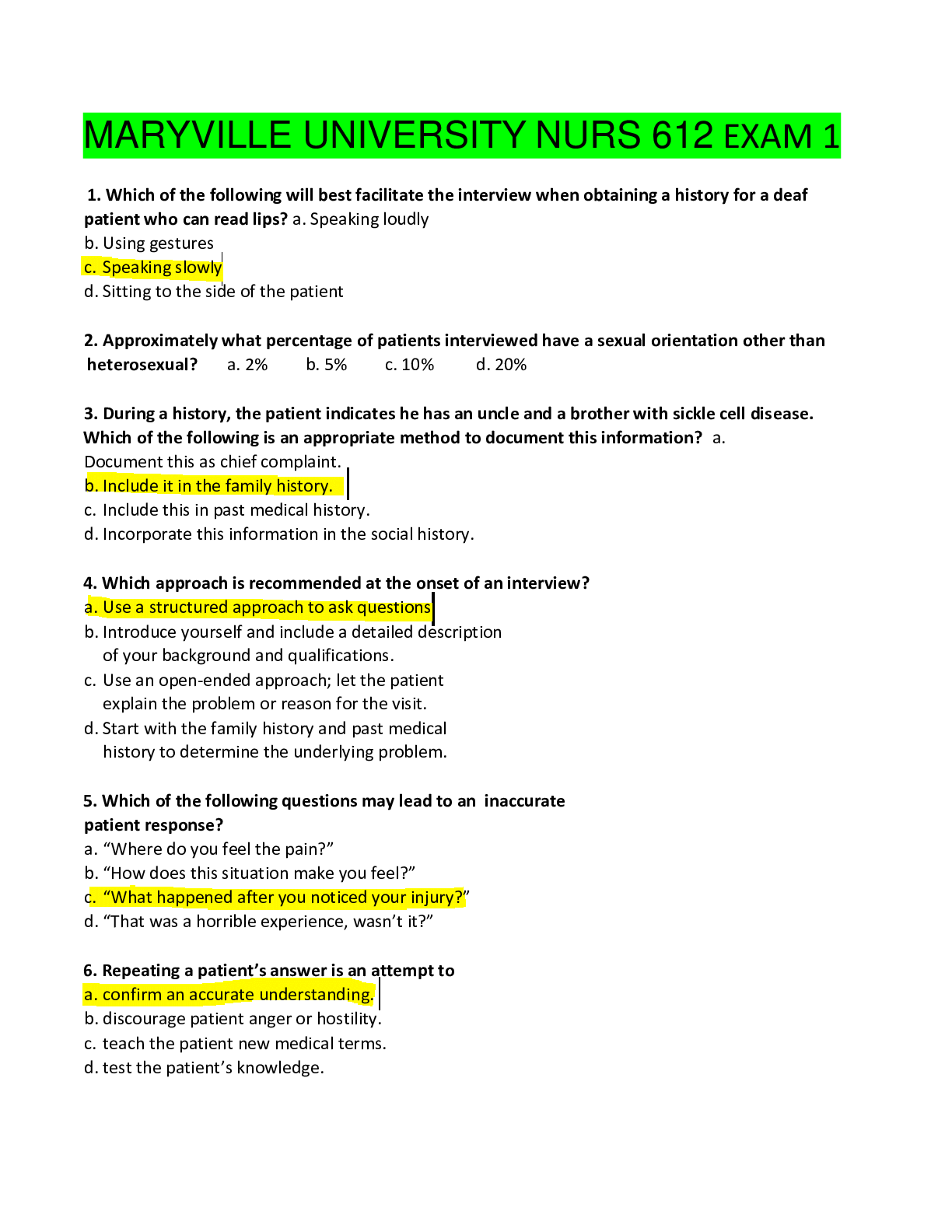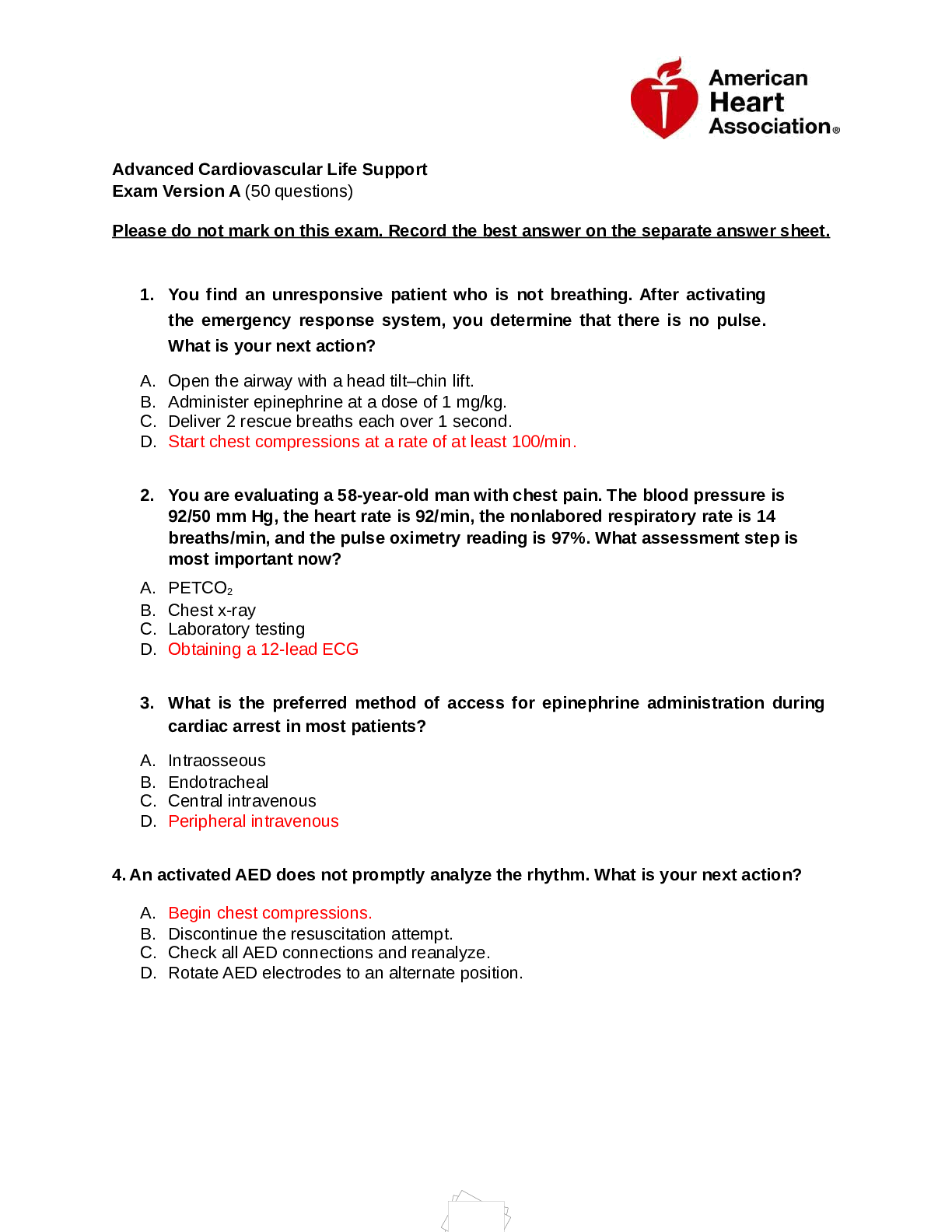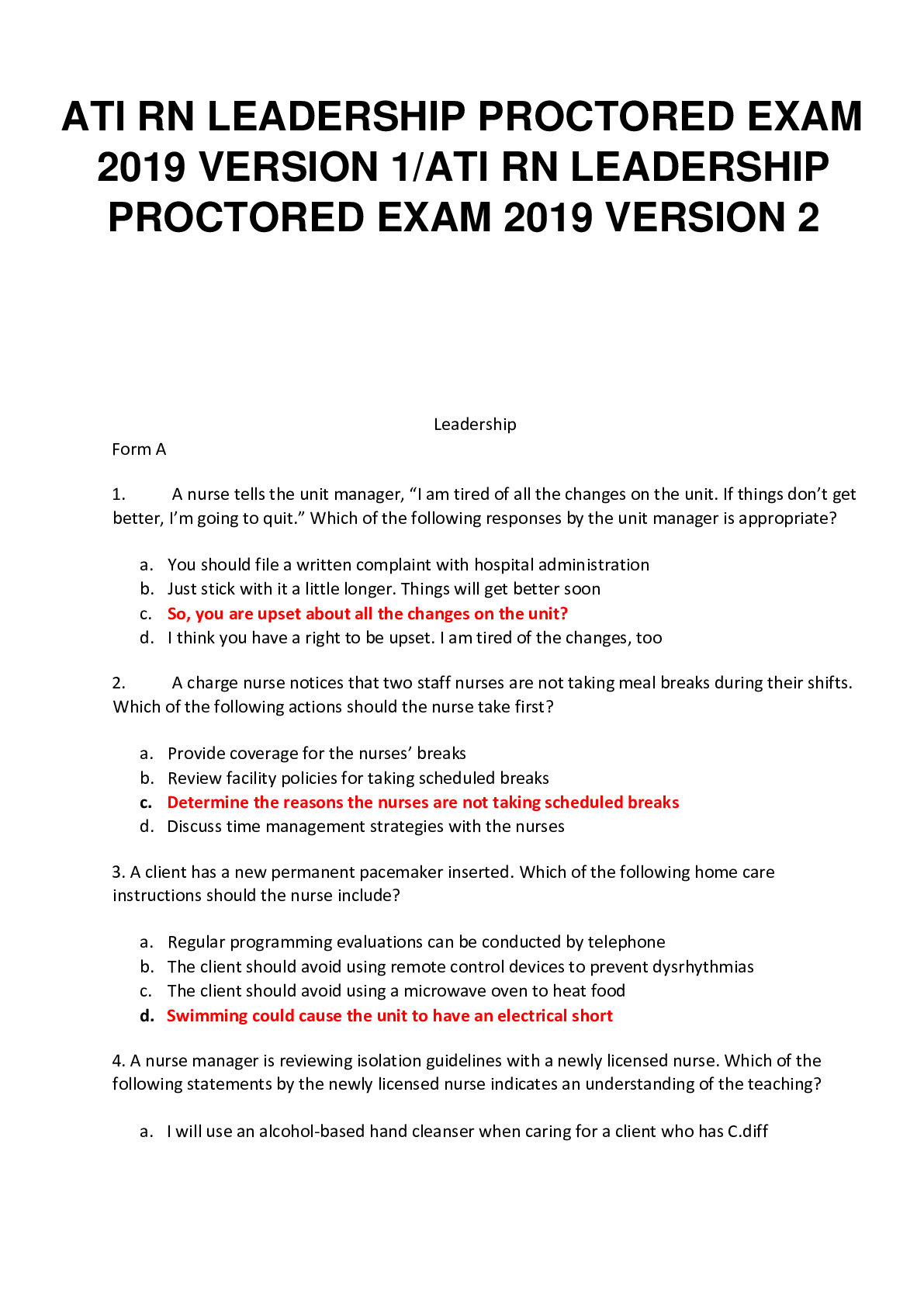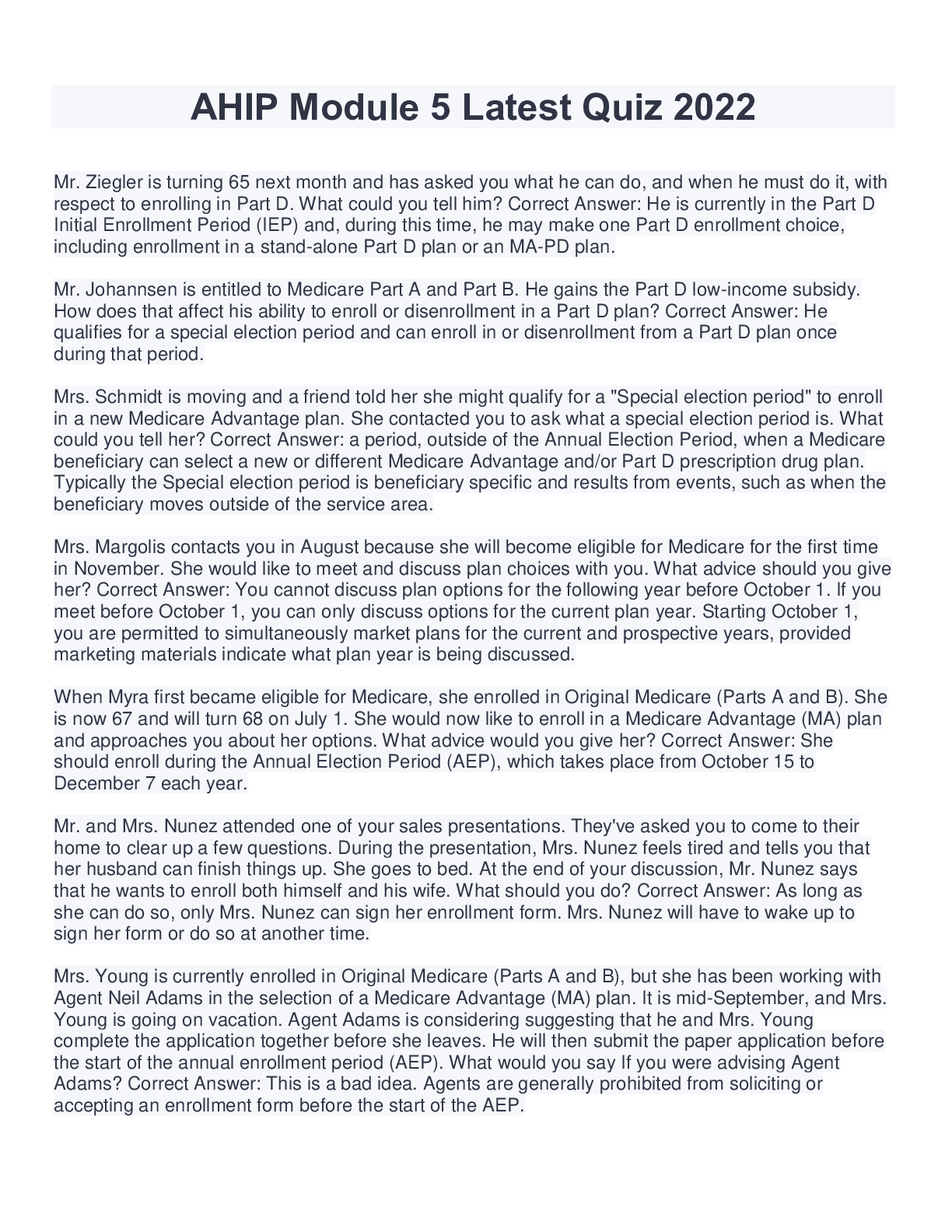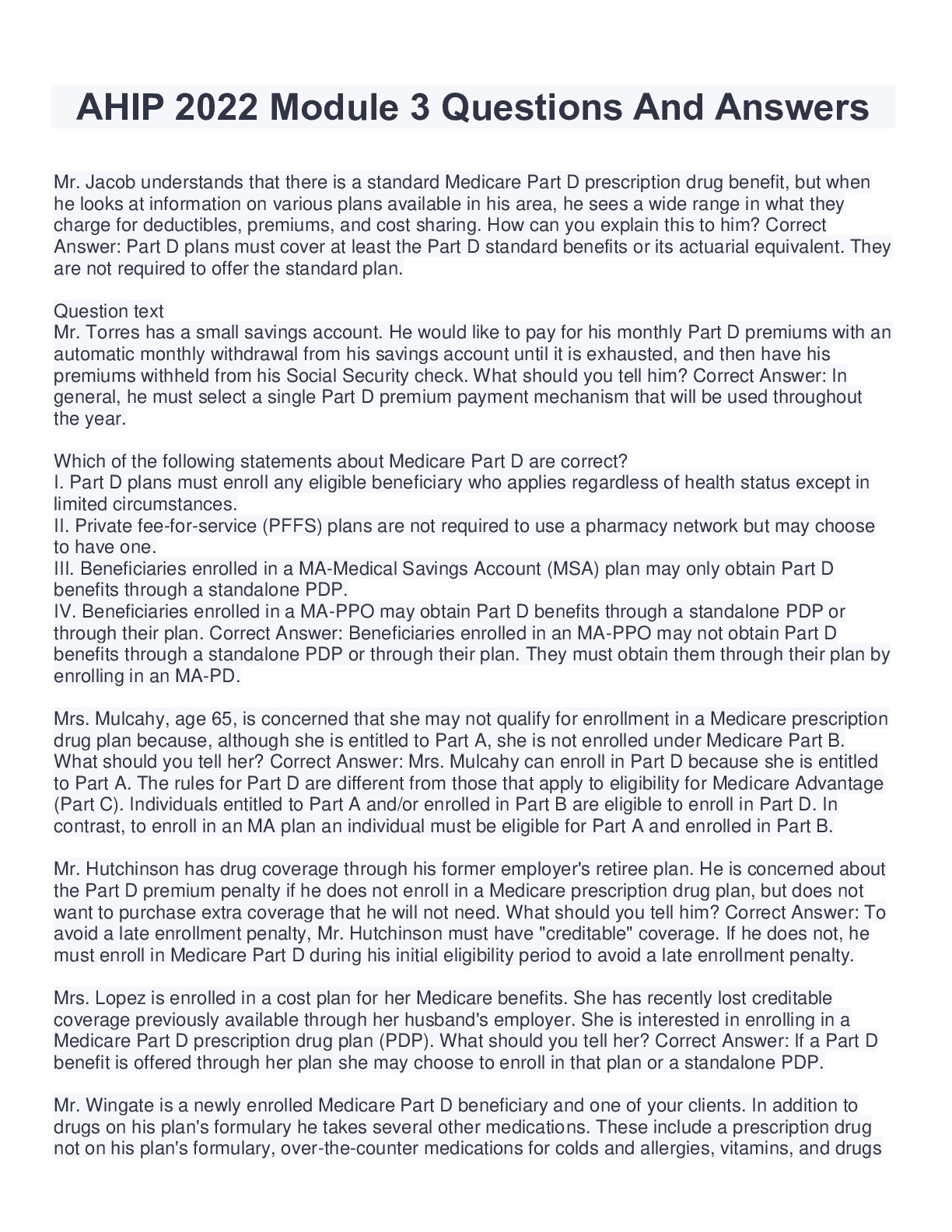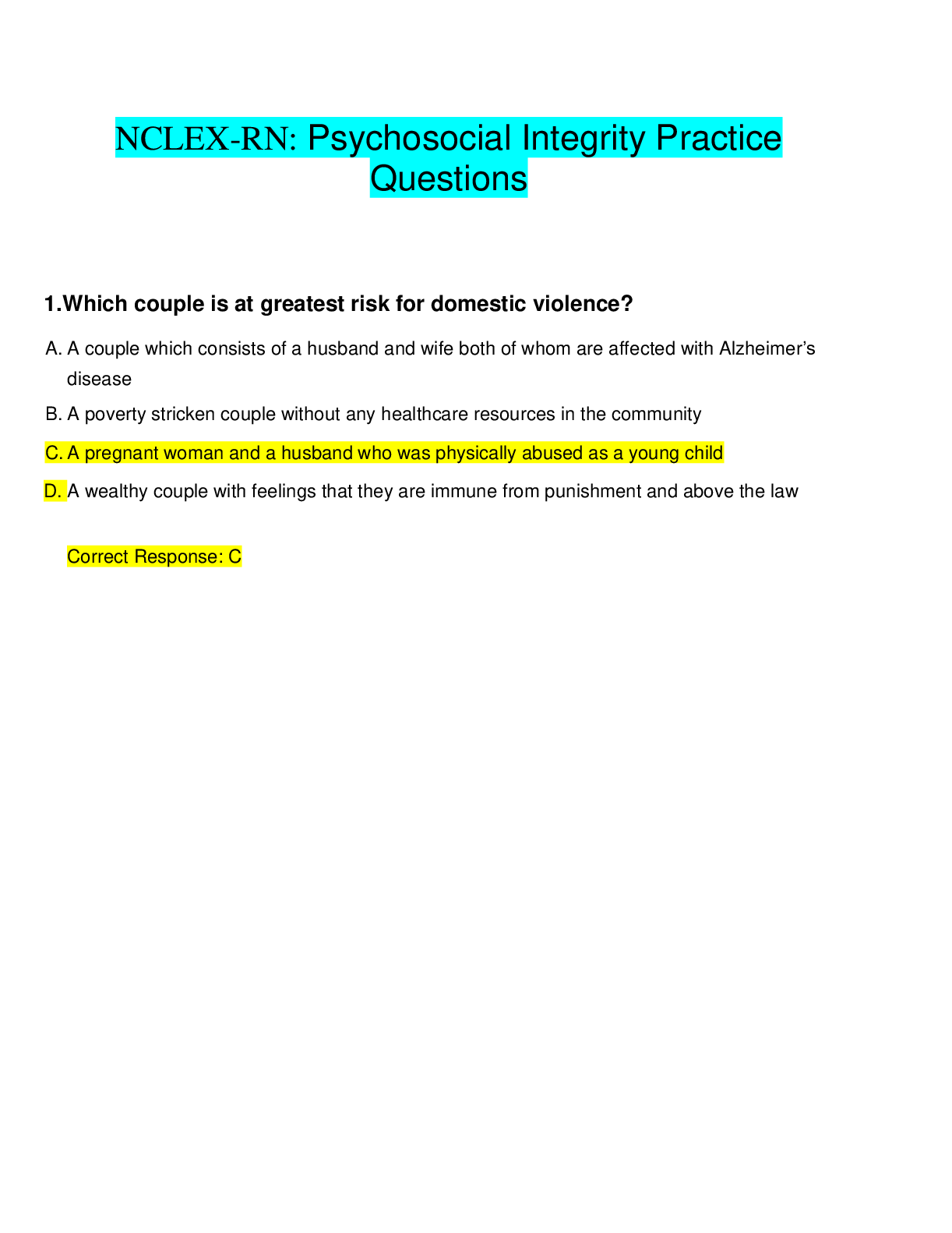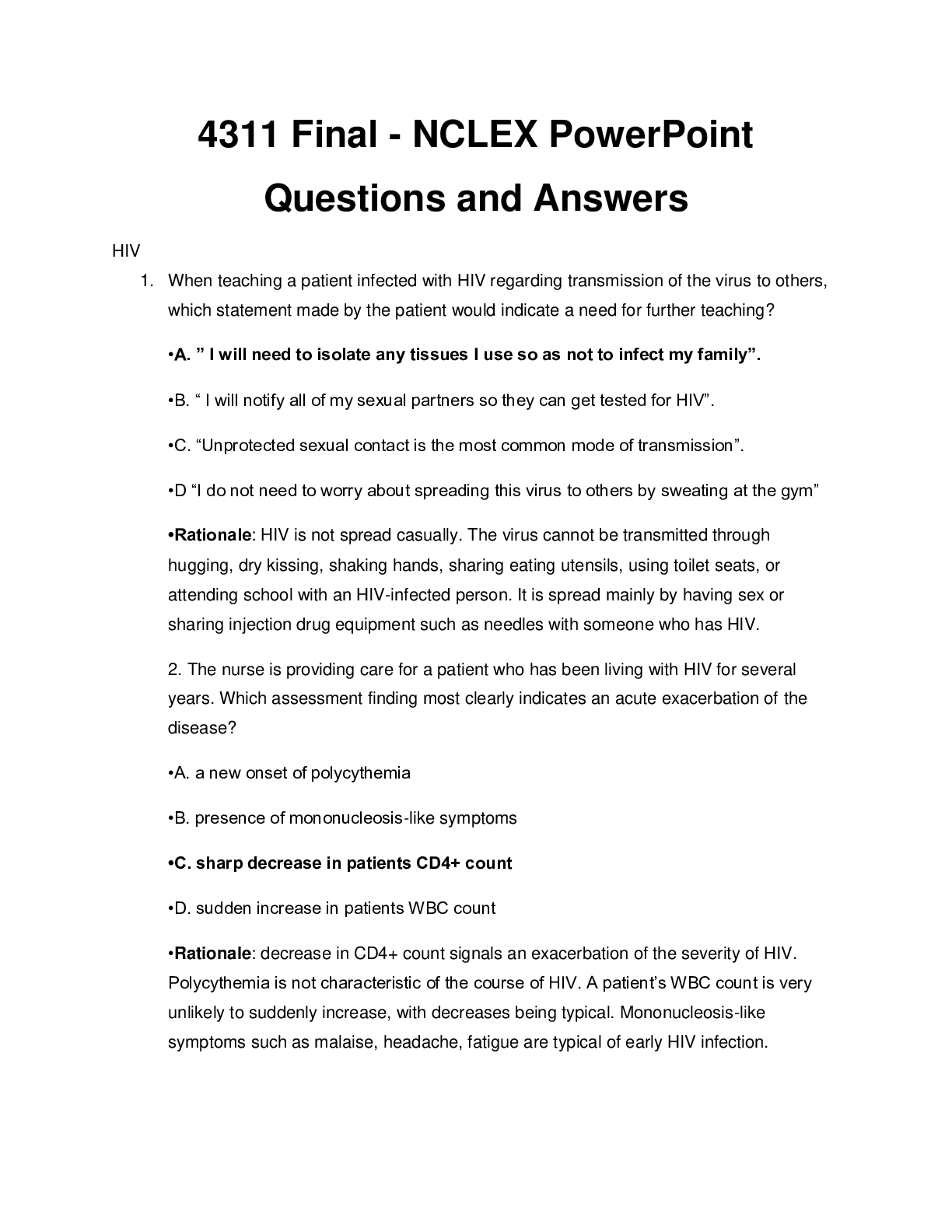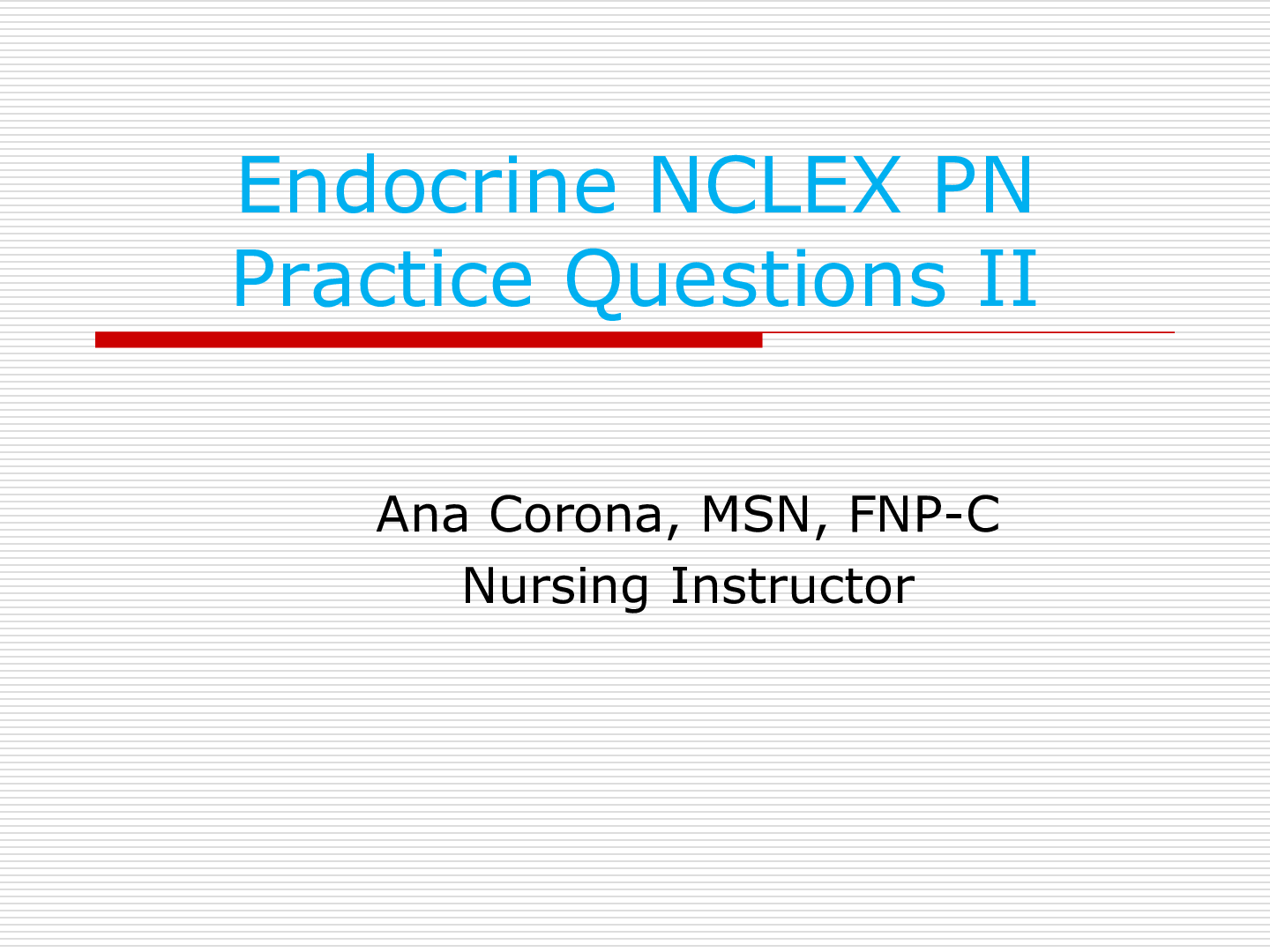Geography > QUESTIONS & ANSWERS > MANAGEMENT 1202 Eng Geo_3 QUASTIONS AND ANSWERS WITH 100% SATISFACTORY ANSWERS (All)
MANAGEMENT 1202 Eng Geo_3 QUASTIONS AND ANSWERS WITH 100% SATISFACTORY ANSWERS
Document Content and Description Below
MANAGEMENT 1202 Eng Geo_3 QUASTIONS AND ANSWERS WITH 100% SATISFACTORY ANSWERS PART A In general, igneous rocks: A. form at relatively high temperatures B. form by crystallization of solid... s from a liquid C. form at high and low pressures D. all of the above Metamorphic rocks are changed rocks. Which of the following rock types could be the "parent" of a metamorphic rock? A. sedimentary B. igneous C. metamorphic D. 1. The approximate density of the earth is a) 5.5 b) 5.8 c) 5.1 d) 5.2 2. Flat-topped seamounts are known as a) Submarine volcanoes b) Guyots c) Groynes d) Terraces 3. Which of the following is a fresh water lake? a) Wuler b) Chilka c) Pulicat d) Sambher 4. The clinometers compass can be used to find the structural trend of rocks containing the minerals a) Magnetite, Pyrite, Sphalerite c) Chromite, Magnetite, Galena b) Galena, Sphalerite, Gold d) None of the above 5. The specific gravity of a powdered mineral can be determined with the help of a) Chemical balance c) Pycnometer b) Jolly’s spring balance d) Walker’s Steel Yard 6. Which of the following is a fresh water fossil a) Physa b) Cerethium c) Nucula d) Ammonite 7. Find the odd man out a) Lamination b) Slaty cleavage c) Schistosity d) Foliation 8. The most abundant sedimentary rock found in the Earth’s crust is a) Shale b) Sandstone c) Limestone d) None of the above 9. Stromatolites are a) Green algae c) Blue algae b) Organo-sedimentary structures d) Sedimentary structure 10. Sill is a a) Horizontal igneous intrusive b) Vertical igneous intrusive c) Concave igneous pluton d) None of the above 11. The main raw material for ceramic industry is a) Silica b) Clay c) Gypsum d) Terracota 12. “Bleaching clays” are a) Fire clays b) Bentonites c) China clays d)Fuller’s earth 13. The outcrop of manganese deposits exhibit color a) Black b) Brown c) Maroon d) Waxy green 14. As one moves from Tropical zones towards the Polar regions, the concentration of limestone a) Increases c) Decrease b) First increases then decreases d) First decreases then increases 15. The Bauxite deposits of Orissa are associated with a) Positive topographic forms b) Negative topographic forms c) Structural elevations d) Tectonic deeps PART B 16. The Graphite deposits of Kalahandi, the Granite deposits of Rajasthan and the Kyanite deposits of Singhbhum are associated with a) Igneous rocks c) Sedimentary rocks b) Metamorphic rocks d) All of the above 17. ‘Trenching’ involves a) Linear excavation b) Linear excavation in which one dimension is greater than other c) Drilling wedge-shaped bore holes d) Digging even-sized pits 18. Diamond drilling can be used to bore holes in a) Horizontal direction only b) Vertical direction only c) Horizontal and vertical directions d) All directions 19. The most useful drilling for penetrating hard or abrasive ground is a) Diamond drilling c) Percussion drilling b) Rotary drilling d) Churn drilling 20. Which of the following is a common method used for sampling of placer deposits a) Churn drilling c) Augur drilling b) Jet drilling d) Rotary drilling 21. The average gravitational force of the earth is a) 98 cm/s2 b) 980 cm/s2 c) 9800 cm/s2 d) 980 cm/s 22. The Value of Universal Gravitational Constant (G) in S.I. unit is a) 6.67 X 10-8 c) 6.67 X 10-10 b) 6.67 X 10-9 d) 6.67 X 10-12 23. The total magnetic field strength is weakest at a) 0o latitude c) 90o latitude b) 30o N – 30o S latitude d) 60o N – 60o S latitude 24. The P-wave velocities are highest in a) Air b) Water c) Sand d) Granite 25. In terms of electric conductivity, granites can be described as a) Good conductors c) Moderate conductors b) Bad conductors d) Semi-conductors 26. Which of the following has the least electrical resistivity a) Diamond b) Sulphur c) Clay d) Anthracite 27. The plants which indicates the presence of groundwater are described as a) Hydrophytes c) Phreatophytes b) Halophytes d) Xerophytes 28. Which of the following instruments is NOT used in geochemical prospecting a) Atomic Absorption Spectrophotometer b) Emission Spectrograph c) Flame photometer d) Optical microscope 29. Gold prospecting in both geophysical and geochemical methods is most effectively done by a) Electromagnetic surveys c) Seismic profiling b) Remote sensing d) Soil analysis 30. Which sampling method is resorted to when the exposure of outcrops are scarce? a) Bulk sampling c) Trenching b) Drilling d) Well-logging 31. The Geological Mapping undertaken by GSI is on the scale of a) 1:50,000 c) 1:40,000 b) 1:65,000 d) 1:25,000 32. Screening is an ore beneficiation process which takes advantage of the differences in a) Size of the particles b) Cleavage or fracture of the particles c) Specific gravity of the particles d) Hardness of the particles 33. Sorting of grains generally carried out by instruments called a) Jaw crushers c) Classifiers b) Cone crushers d) Vibrating screen 34. Water that is formed at the time of consolidation of magma is termed a) Connate water c) Meteoric water b) Vadose water d) Juvenile water 35. The underground water that occurs within the zone of aeration is called a) Plutonic water c) Vadose water b) Meteoric water d) Connate water 36. Which of the following is the most feebly magnetic among the following? a) Quartz b) Rutile c) Magnesite d) Galena 37. Permanent magnets are used in a) Low-intensity magnetic separators b) High-intensity magnetic separators c) Wet magnetic separators d) None of the above 38. A horizontal entry into an ore body is called a) Adit b) Shaft c) Bench d) Pit 39. Which of the following are more suitable for underground mining of ore bodies situated at great depths? a) Horizontal shafts c) Inclined shafts b) Vertical shafts d) None of the above 40. Which of the following is an underground mining method using artificially supported openings? a) Open stoping c) Room and pillar mining b) Shrinkage opening d) Longwall mining PART C 41. Minerals in which a country has total inadequacy and depend upon foreign sources for its needs are described as a) Strategic minerals b) Critical minerals c) Essential minerals d) Expendable minerals 42. Hail is a type of precipitation that consists of a) Ice crystals of delicate, feathery structure b) Hard pallets of ice c) Droplets of water deposited on objects near the ground d) Minute crystals of ice deposited on a cold surface 43. A dense mass of water on smoke or dust particles in the lower atmospheric layers constitute a) Fog b) Mist c) Frost d) Blizzard 44. A majority of aquifer consists of a) Sand and gravels b) Sandstones c) Limestones d) Porous breccias and conglomerate 45. An impermeable formation that neither contains nor transmit water is called a) Aquifer b) Aquiclude c) Aquifuge d) Aquitard 46. In general, fine-grained rocks have a) High porosity b) High permeability c) High porosity and permeability d) High porosity and low permeability 47. Which of the following materials has the highest porosity? a) Clay b) Silt c) Gravels d) Sandstones 48. Which of the following has the least stiffness? a) Limestone b) Sandstone c) Quartz d) Basalt 49. The type of dam preferred where the river section is wide and the foundation is unsound is a) Gravity dam b) Embankment dam c) Arch dam d) Multiple arch dam 50. The soil that is most characteristic of the Archaean basement of the peninsular India is a) Alluvial soil b) Laterite soil c) Red soil d) Regur 51. The time taken for light from the sun to reach the earth a) 499.720 secs b) 499.012 secs c) 489.720 secs d) 489.012 secs 52. Which of the following possess both stellar and planetary characteristics? a) Jupiter b) Venus c) Saturn d) Pluto 53. Which of the following planets has the least density? a). Earth b) Mars c) Saturn d) Venus 54. The difference between the equatorial and polar diameters of the Earth is a) 21 km b) 43 km c) 56 km d) 28 km 55. Earthquakes whose depth of focus ranges between 300-700 km are known as a) Shallow focus earthquakes b) Intermediate focus earthquakes c) Deep focus earthquakes d) Normal earthquakes 56. The Tethys was located between a) North America and South America b) North America and Eurasia c) Eurasia and Africa d) Antarctica and Australia 57. The most extensive modern continental mountain chain is a) Andes b) Himalayas c) Alps d) Zagros 58. Which of the following is NOT a closing ocean basin? a) Black sea b) Red sea c) Caspian sea d) Mediterranean sea 59. The oldest rocks in the world are found in a) Australian craton b) Indian craton c) Antarctica d) Greenland 60. The oldest minerals found on the surface of the Earth are crystals of a) Calcite b) Quartz c) Tourmaline d) Zircon 61. Exfoliation is a form of a) Physical weathering b) Chemical weathering c) Biochemical weathering d) Mass wasting 62. Flat-topped hills or small mountains formed by stream action are called a) Mesas b) Buttes c) Cuestas d) Stream terraces 63. Stream which flows in the opposite direction to the original consequent streams are described as a) Obsequent b) Subsequent c) Insequent d)Resequent 64. ‘Natural levee’ is an example of a) Point-bar deposits b) Channel-fill deposits c) Flood plain deposits d) Flood basin deposits 65. Which of the following is a feature exhibited by a river in its upper course a) Meanders b) River-piracy c) Piedmont d) Sloughs 66. Coral reefs are generally found in the latitudinal extensions of a) 20oN – 20oS b) 30oN – 30oS c) 60oN – 60oS d) 45oN – 45oS 67. Soils in which sand, clay and humus are found more or less in equal proportions are called a) Loamy soils b) Regur c) Chernozem d) Pedalfar 68. The exoskeleton of sponges is made up of a) Silica b) Calcite c) Aragonite d) Calcium phosphate 69. Fossil fecal pellets of ancient animals are described as a) Gastroliths b) Coproliths c) Beekite rings d) Pseudo-fossils 70. The most favourable environment for the preservation of fossils is a) Terrestrial b) Lacustrine c) Fluvial d) Marine Multiple Choices (chose the correct or the best answer) The minimum water content at which the soil retains its liquid state and also possesses a small shearing strength against flowing, is known A. liquid limit B. plastic limit C. shrinkage limit D.permeability limit. Minimum size of the particles of silt soil, is B.0.04 mm C.0.06 mm. D.0.08 mm E. 1 mm . Pick up the clay soil group which does not swell when wet from the following : A.Kaolinite group B.Mite group C. Vermiculite group D.Montrorillonite group. The ratio of the volume of voids to the volume of soil solids in a given soil mass, is known A.porosity B. specific gravity D.water content. A compacted soil sample using 10% moisture content has a weight of 200 g and mass unit weight of 2.0 g/cm3. If the specific gravity of soil particles and water are 2.7 and 1.0, the degree of saturation of the soil is A.11.1% C.69.6% D.none of these. A partially saturated sample of soil has a unit weight of 2.0 g/cm3 and specific gravity of soil particles is 2.6. If the moisture content in the soil is 20%, the degree of saturation is A.20% B.77% D.none of these. The water content of soil is defined as the ratio of A.volume of water to volume of given soil B. volume of water to volume of voids in soil C. weight of water to weight of air in voids D. weight of water to weight of solids of given mass of soil. The liquid limit and plastic limit exist in A.sandy soils B.silty soils C.gravel soils D.clay soils. The ratio of the weight of given volume of soil solids to the weight of an equal volume of distilled water at the given temperature, is known A. porosity B. specific gravity C. void ratio D. water content. A soil has bulk density 2.30 g/cm3 and water content 15 per cent, the dry density of the sample, is A.1.0 g/cm3 B.1.5 g/cm3 C.2.0 g/cm3 D.2.5 g/cm3 The clay soil mainly consists of A.Kaolinites . B.Montomorillonite C.Illites D.Vermiculite The liquidity index is defined as a ratio expressed as percentage of A.plastic limit minus the natural water content, to its plasticity index B.natural water content minus its plastic limit to its plasticity index C. natural water content plus its plastic limit to its plasticity index D.liquid limit minus the natural water content to the plasticity index. The relationship between void ratio (e) and porosity ratio (n) is : A.n = (1+e)/(1-e) B. e= (1+n)/(1-e) C. n=e/(1-e) D. e=n/(1-n) Geologic cycle for the formation of soil, is A. Upheavel → transportation → deposition → weathering B. Weathering → upheaval → transportation → deposition C. Transportation → upheaval → weathering → deposition D.Weathering → transportation → deposition → upheaval E. None of these. The weight of a pycnometer containing 400 g sand and water full to the top is 2150 g. The weight of pycnometer full of clean water is 1950 g. If specific gravity of the soil is 2.5, the water content is A.5% B.10% C.15% For determining the moisture content of a soil sample, the following data is available Weight of container = 260 g, Weight of soil sample and = 320 g container, Weight of soil sample (dried) and = 310 g container. The moisture content of the soil sample, is A.15% B.18% D.25% A partially saturated soil is classified as A.one phase soil B.two phase soil C.three phase soil D.four phase soil. A fundamental equation of void ratio(e), specific gravity (G), water content (ω) and degree of saturation (Sr) is B.ω = e.G/Sr C.G = eW/S D.Sr = e.W/G Water content of a soil sample is the difference of the weight of the given sample at the given temperature and the weight determined after drying it for 24 hours at temperature ranging from A. 0° to 90°C B.90° to 95°C C.95° to 100°C D.103° to 105°C The soil which contains finest grain particles, is A.coarse sand B. fine sand C. silt D.clay. The general relationship between specific gravity (G), weight of water (γW), degree of saturation (Sr), void ratio (e) and bulk density (γ), is A.γ =(S-e.Sr)W/(1+e) B.γ =(G-e.Sr)W/(1+e) C.γ =(1+e)W/(G+Sr) D.γ =(1-Sr)e/(G+Sr) Determination of water content of a soil sample suspected to contain gypsum is made by drying the sample for longer period at a temperature not more than A. 0°C C.100°C D.110°C Water formed transported soil is B. marine C. lacustrine D.loess. The vane shear test is used for the in-situ determination of the undrained strength of the intact fully saturated A.sands B.clays C. gravels D.highly organic soils. undamental relationship between dry density (γd), bulk density (γ) and water content (W), is : C. ω = /(1+d) D. ω =/(1+d) Maximum size of clay particles, is : B. 0.04 mm C. 0.06 mm D.0.08 mm 1 mm If the unit weight of sand particles is 2.696 g/cc. and porosity in loose state is 44%, the critical hydraulic gradient for quick sand condition, is A.0.91 B. 0.92 C.0.93 D.0.94 A sample of saturated soil has 30% water content and the specific gravity of soil grains is 2.6. The dry density of the soil mass in g/cm3, is B. 1.82 C. 1.91 D.none of these. The specific gravity of sands, is approximately A.1.6 B.2.0 C. 2.2 D.2.4 Answer: Option E Darcy's law is applicable to seepage if a soil is A.homogeneous B.isotropic C. incompressible The factor which affects the compaction, is A.moisture content B. compacting content C. method of compaction D. type of soil The compression resulting from a long term static load and consequent escape of pore water, is known as A.compaction C.swelling D.none of these. Soil classification of composite soils, exclusively based on the particle size distribution, is known A.particle classification C. High Way Research Board classification D.unified soil classification. A moist soil sample weighing 108 g has a volume of 60 cc. If water content is 25% and value of G = 2.52, the void ratio is A.0.55 B. 0.65 D.0.80 Cohesive soils are generally A.plastic and also compressible B. elastic and also compressible C. plastic but incompressible D. none of these. The total weight of a pycnometer with water and oven dried soil 20 (g) is 1600 g. The pycnometer filled with water alone weighs 1500 g. The specific gravity of the soil, is A.1.0 B. 1.5 D.2.5 The angle of internal friction, is least for A.angular-grained loose sand B.angular -grained dense sand C.round-grained loose sand D.round-grained loose sand E. clays. The expression G.ρW /(1+W.Gs) is used for A.dry density B. bulk density C. degree of saturation D. optimum water content. . The shear strength of a soil A. increases with an increase in the normal stress B. is proportional to the cohesion of the soil C. is generally known as the strength of the soil D. is proportional to the tangent of the angle of internal friction The property of a soil which permits water to percolate through it, is called A.moisture content B. permeability C.capillarity D.none of these. A direct shear test possesses the following disadvantage: A.A relatively thin thickness of sample permits quick drainage B.A relatively thin thickness of sample permits quick dissipation of pore pressure developed during the test C. As the test progresses the area under shear, gradually changes D.none of these. If water content of a soil is 40%, G is 2.70 and void ratio is 1.35, the degree of saturation is A.70% B.75% D. 5% E. 90% Chemical weathering of soil is caused due to A.oxidation B. carbonation C.hydration D.leaching E. all the above. Cohesionless soil is A.sand B. silt C. clay D. clay and silt. Multiple Choices (chose the correct or the best answer) 1. Which of the following best defines a mineral and a rock? A) A rock has an orderly, repetitive, geometrical, internal arrangement of minerals; a mineral is a lithified or consolidated aggregate of rocks. B) A mineral consists of its constituent atoms arranged in a geometrically repetitive structure; in a rock, the atoms are randomly bonded without any geometric pattern. C) In a mineral the constituent atoms are bonded in a regular, repetitive, internal structure; a rock is a lithified or consolidated aggregate of different mineral grains. D) A rock consists of atoms bonded in a regular, geometrically predictable arrangement; a mineral is a consolidated aggregate of different rock particles. 2. Which of the following is not a mineral? A) olivine B) limestone C) calcite D) quartz 3. Which geologic concept is described by "the present is the key to the past"? A) biblical prophesy B) uniformitarianism C) Aristotelian logic D) catastrophism 4. The average thickness of the continental crust is about A) 35-40 km B) 100-200 km C) 1000-2000 km D) 5-10 km 5. In correct order from the center outward, Earth includes which layers? A) core, inner mantle, outer mantle, crust B) inner core, outer core, mantle, crust C) inner core, crust, mantle, hydrosphere D) core, crust, mantle, hydrosphere 6. The tectonic plates A) are the outermost shell of the solid Earth. B) are a rigid, solid layer about 100 km thick C) includes the crust and the uppermost mantle D) all of the above 7. At mid-ocean ridges, two plates are A) moving towards each other. B) moving away from each other. C) sliding along each other. D) stationary. 8. According to Plate Tectonics theory, most active volcanoes occur A) on continents. B) in large tectonic plates. C) along plate boundaries. D) randomly over continents. 9. What are the two most abundant elements in the Earth’s crust? A) iron and magnesium B) oxygen and silicon C) nitrogen and oxygen D) silicon and calcium 10. Atoms of the same element (oxygen, for example) have the same number of . A) electrons in the nucleus B) protons in the nucleus C) neutrons in the outer nuclear shell D) electrons in the valence bond level 11. In table salt (NaCl), sodium and chlorine atoms bond by A) sharing the electrons in their outer shells. B) transferring an electron in the outer shell of the sodium atom to the outer shell of the chlorine atom. C) having valence electrons freely migrating among the ions of sodium and chlorine. D) all above. 12. What mineral is the hardest known substance in nature? A) graphite B) native gold C) diamond D) muscovite 13. Why is basalt finer grained than gabbro? A) gabbro formed from quick cooling of magma. B) basalt formed from quick cooling of magma. C) basalt has a mafic composition. D) gabbro has a mafic composition. 14. Visible quartz and potassium feldspar grains are the main constituents in a . A) granite B) gabbro C) basalt D) rhyolite 15. Which of the following minerals would crystallize early from a cooling silicate magma? A) biotite B) quartz C) olivine D) muscovite 16. Magma generation in subduction zones are mainly caused by A) releasing of water and volatiles from the subducting plate B) pressure release in the subducting plate C) temperature increase in the surrounding mantle D) all above 17. Which of the following tend to increase the explosive potential of a magma body beneath a volcano. A) High viscosity and dissolved gas B) High viscosity; low dissolved gas content C) Low silica content, low viscosity D) Low viscosity; low dissolved gas content 18. Eruptions dominated by basaltic lava flows typically form what type of volcanoes? A) composite B) stratospheric C) cinder cone D) shield 19. Why do magmas rise toward Earth's surface? A) Magmas are more viscous than solid rocks in the crust and upper mantle. B) Most magmas are richer in silica than most crustal and upper mantle rocks. C) Magmas, being melts and having gases, are less dense than the adjacent solid rock. D) magmas have higher content of pyroxenes than the surrounding rocks. 20. Which of the following is NOT a process of physical (mechanical) weathering? A) Frost wedging B) unloading C) thermal expansion D) dissolution 21. Which of the following silicate minerals are most resistant to chemical weathering? A) quartz B) olivine C) hornblende D) potassium feldspar 22. In the soil profile, the A horizon A) is located below the O horizon B) is called the zone of leaching C) is part of the “top soil” D) all above 23. What is probably the single most important, original, depositional feature in sedimentary rocks? A) sizes of the sand grains B) degree of lithification C) bedding or stratification D) compaction of the mud and clay 24. What is the main difference between a conglomerate and a sedimentary breccia? A) Breccia clasts are angular; conglomerate clasts are rounded. B) A breccia is well stratified; a conglomerate is poorly stratified. C) Breccia clasts are the size of baseballs; conglomerate clasts are larger. D) Breccia has a compacted, clay-rich matrix; conglomerate has no matrix. 25. Detrital sedimentary rocks are classified (named) based on the A) colors of the cementing minerals B) grain sizes of the detrital particles C) compositions of soluble minerals D) degree of compaction and lithification 26. Flint, chert, and jasper are microcrystalline forms of . A) quartz; (SiO2) B) hematite (Fe2O3) C) halite (NaCl) D) calcite (CaCO3) 27. Which of the following is the most common type of chemical sedimentary rock. A) Limestone B) Chert C) Phosphate rock D) Quartz sandstone 28. Which of following sedimentary rocks indicate long-distance transportation of the sediements? A) quartz sandstone B) breccia C) arkose (sandstone with lots of feldspar particles) D) none of above 29. Which of the following forms at the highest grade of regional metamorphism? A) gneiss B) schist C) slate D) phyllite 30. What major change occurs during metamorphism of limestone to marble? A) calcite grains recrystallize to larger and interlocked grains. B) clays crystallize to micas, forming a highly foliated, mica-rich rock C) limestone grains react to form quartz and feldspars D) calcite grains are dissolved away leaving only marble crystals 31. What type of foliation results from the parallel alignment of abundant, coarse-grained, mica flakes in a metamorphic rock? A) schistosity B) gneissic banding C) slaty cleavage D) phyllitic structure 32. Metamorphic rocks can form from A) sedimentary rocks B) igneous rocks C) metamorphic rocks D) all above. 33. For undisturbed, horizontal strata of sedimentary rocks, their age A) increases from top to bottom B) decreases from top to bottom C) can be determined from their color D) is the same 34. What makes a good index fossil? A) big and easy to see in the field B) with a hard shell that can be easily preserved C) spans over a long geological time period D) widespread geographically and limited to a short span of geological time. 35. An igneous rock contains a radioactive isotope that has a half-life of 10 million years. Careful analysis shows that only one quarter of the original concentration of the parent isotope is left. How old is this igneous rock? A) 5 million years old B) 20 million years old C) 40 million years old D) 2.5 million years old 36. Which of the geological era is the youngest in the geologic time scale? A) Precambrian. B) Mesozoic. C) Paleozoic. D) Cenozoic. 37. Lateral offset in drainage lines is commonly associated with A) normal faults. B) reverse faults. C) thrust faults. D) strike-slip faults. 38. Ductile deformation become important when A) the temperature is hign B) the confining pressure is high C) deformation happens slowly D) all above 39. In an structural basin, the youngest strata is found A) at the center of the basin B) on the margins of the basin C) half-way between the center and the margins of the basin D) beneath the older strata. 40. Which statement best describes motion on a normal fault? A) The hanging wall block moved downward relative to the footwall block. B) The hanging wall block moved upward relative to the footwall block. C) The hanging wall block moved horizontally relative to the footwall block. D) Faults are simple breaks in the crust along which no movement has occurred. [Show More]
Last updated: 1 year ago
Preview 1 out of 23 pages
Instant download
.png)
Buy this document to get the full access instantly
Instant Download Access after purchase
Add to cartInstant download
Reviews( 0 )
Document information
Connected school, study & course
About the document
Uploaded On
Jan 01, 2021
Number of pages
23
Written in
Additional information
This document has been written for:
Uploaded
Jan 01, 2021
Downloads
0
Views
58


